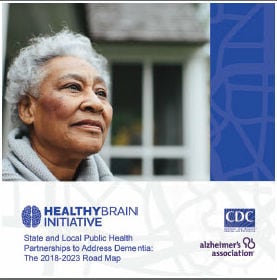Data and Evidence for Action
A Health Brain Initiative Issue Map
EXPANDING AND IMPROVING DATA COLLECTION to Make Alzheimer’s Our Next Public Health Success Story
With the number of people living with Alzheimer’s estimated to nearly triple by 2050 — reaching up to 14 million1 — it is necessary to monitor the health and needs of this growing population.
Surveillance is a fundamental and essential public health tool for understanding the prevalence, scope, and burden of Alzheimer’s, other dementias, cognitive issues, and dementia caregiving. One specific data collection method that public health can utilize is the Behavioral Risk Factor Surveillance System (BRFSS), an annual health behavior survey administered in every state, the District of Columbia, and the U.S. territories.
» The BRFSS Cognitive Decline Module asks about subjective cognitive decline, the potential difficulties it may cause with everyday activities, and whether people have discussed their memory challenges with a healthcare professional.
» The BRFSS Caregiver Module includes questions about caregiving status, the care recipient’s health issues, and greatest care needs. It also provides insight into the scope and burden of caregiving responsibilities.
State and local data from the BRFSS and other sources can help communities identify health disparities, assist with planning efforts, and direct resources to maximize impact. Comprehensive needs assessments use existing data from many areas to better understand communities’ needs and identify assets that can be leveraged. This capability is especially needed to assess gaps in workforce capacity to support the current and future needs of an aging population.
Effective public health practice relies on evaluation of training and programmatic activities to determine what difference they made and for whom. Evaluation should assess quality, reach, and effectiveness across the care spectrum including healthcare, public health, emergency response, law enforcement, caregiver support, and home and community-based services. Public health can also improve the effectiveness of these sectors by educating providers about the best available evidence regarding cognitive impairment, dementia, and caregiving.
COMPELLING DATA
In 2015-2016, 49 states, the District of Columbia, and Puerto Rico used the BRFSS Cognitive Decline Module, generating a nationwide sample of more than 227,000 respondents aged 45 and older. Centers for Disease Control and Prevention (CDC) analysis of these data indicates:
11.2% of U.S. Adults aged 45 and older reported subjective cognitive decline (SCD).
Among people with SCD, 50.6% reported having difficulties with everyday activities because of their SCD.
15.2% of adults aged 45 and older with another chronic condition reported SCD.
Of adults who lived alone, more than 1 in 8 (13.8%) reported SCD.²
In 2015-2016, 38 states, the District of Columbia, and Puerto Rico administered the BRFSS Caregiver Module to a sample of respondents aged 18 and older. CDC analysis of these data indicates:
Approximately 1 in 5 adults aged 18 and older reported providing regular care or assistance to a friend or family member with a health problem or disability.
Of those caregivers who provided care due to Alzheimer’s or other cognitive impairment, 56.1% reported assisting with both personal care (such as bathing, feeding, or dressing) and household tasks (such as cleaning, managing money, or cooking) and nearly 1 in 4 (24.6%) had provided care for 5 years or more.³
More than half of caregivers for people with dementia had low or no knowledge of formal support services in the community.4
- Alzheimer’s Association. (2019). 2019 Alzheimer’s disease facts and figures. Alzheimer’s Dement; 15(3):321 87. Available at: alz.org/facts.
- Taylor, CA, Bouldin ED, McGuire LC (2018). Subjective cognitive decline among adults ≥ 45 years—49 States, Puerto Rico, and the District of Columbia, 2015–2016. MMWR Morb Mortal Wkly Rep 2018;67:753-757.
- Rabarison KM, Bouldin ED, McGuire LC, Bish CL, Taylor CA, Greenlund KJ (2018). Economic Value of Informal Caregiving for Persons with Dementia; Results from 38 States, DC, and Puerto Rico, 2015 and 2016 BRFSS. Amer J Pub Hlth, 108(10):1370-1377.
- Duchame F. Levesque L, Lachance L, Kergoat MJ, Coulombe R. (2011). Challenges associated with transition to caregiver role following diagnostic disclosure of Alzheimer’s disease: a descriptive study. Int J Nurs Stud;48(9):1109-19.
THE DATA AND EVIDENCE ACTION AGENDA
The Healthy Brain Initiative’s (HBI) State and Local Public Health Partnerships to Address Dementia, The 2018–2023 Road Map charts a course for state and local public health agencies and their partners to act quickly and strategically to prepare all communities by stimulating changes in policies, systems, and environments. Many of the Road Map’s 25 expert-developed actions would help promote data collection and analysis of Alzheimer’s and other dementias, and related topics.

E-2
Integrate the best available evidence about brain health and cognitive decline risk factors into existing health communications that promote health and chronic condition management for people across the life span.
E-7
Improve access to and use of evidence-informed interventions, services, and supports for people with dementia and their caregivers to enhance their health, well-being, and independence.

P-2
Assure academic programs, professional associations, and accreditation and certification entities incorporate the best available science about brain health, cognitive impairment, and dementia caregiving into training for the current and future public health workforces.
P-3
Support better informed decisions by educating policymakers on the basics of cognitive health and impairment, the impact of dementia on caregivers and communities, and the role of public health in addressing this priority problem.
P-4
Improve inclusion of healthcare quality measures that address cognitive assessments, the delivery of care planning to people with diagnosed dementia, and improved outcomes.

W-1
Educate public health and healthcare professionals on sources of reliable information about brain health and ways to use the information to inform those they serve.
W-3
Educate public health professionals about the best available evidence on dementia (including detection) and dementia caregiving, the role of public health, and sources of information, tools, and assistance to support public health action.

M-1
Implement the Behavioral Risk Factor Surveillance System (BRFSS) optional module for Cognitive Decline in 2019 or 2020, and the BRFSS optional module for Caregiving in 2021 or 2022.
M-2
Support national data collection on dementia and caregiving.
M-3
Use data gleaned through available surveillance strategies and other sources to inform the public health program and policy response to cognitive health, impairment, and caregiving.
M-4
Embed evaluation into training and caregiving support programs to determine program accessibility, effectiveness, and impact.
M-5
Estimate the gap between workforce capacity and anticipated demand for services to support people with dementia and their caregivers.

For the full HBI Road Map, data, ready-touse
resources, and case studies, visit:
alz.org/publichealth or cdc.gov/aging.
PUBLIC HEALTH STRATEGIES TO EXPAND AND IMPROVE DATA COLLECTION
The following are examples of how public health departments are using data and evidence to address Alzheimer’s and other dementias.
SOUTH DAKOTA

In 2017, the South Dakota Alzheimer’s Disease and Related Dementias State Plan Work Group — tasked with developing the state’s first plan to address dementia — conducted a needs assessment on 1) the current availability, accessibility, affordability, and quality of resources for people living with dementia; 2) public awareness and understanding of Alzheimer’s and other dementias; and 3) the lived experience of people impacted by dementia across South Dakota.
The needs assessment consisted of 90-minute focus
groups held throughout the state, an online survey to complement the focus groups, and analysis of statespecific population projections, social and economic factors, healthcare workforce capacity, and caregiving concerns. This process produced qualitative data about the needs and challenges of people living with Alzheimer’s, their families, and caregivers. The assessment also revealed the most pressing needs of people currently impacted by dementia.
The report was presented to the South Dakota Legislature to support the need for creating a state plan on Alzheimer’s. In late 2018, the South Dakota State Plan to Address Alzheimer’s Disease and Other Dementias was published, incorporating recommendations from the needs assessment.
OHIO

Summit County Public Health Department (SCPHD) partnered with the Alzheimer’s Association Greater East Ohio Area Chapter to use local data to increase public awareness of cognitive health concerns and enable community leaders to begin planning a stronger community-wide response.
SCPHD performed local-level data analysis for the entire county — as well as 20 sub-county geographic regions — on several factors associated with increased risk of Alzheimer’s and other dementias including age, gender, race, and education level. Poverty status was used to consider populations that may have potentially reduced access to medical care or services that support hearthealthy lifestyles. SCPHD also examined the Alzheimer’s mortality rate from 2000 to 2016 and additional demographic factors.
In June 2018, Summit County published Alzheimer’s Disease in Summit County Statistics Brief — a publication examining the impact and burden of Alzheimer’s within the county. When feasible, the brief contrasts local-level data with national or Ohio-specific facts, helping readers consider how dementia differentially impacts Summit County.
The release of the brief coincided with national Alzheimer’s & Brain Awareness Month. Both Akron.com and The West Side Leader publicized the brief, leading to 42,372 print impressions. The Greater East Ohio Area Chapter disseminated the brief, reaching 10,088 newsletter subscribers. It continues to inform residents and healthcare professionals about Alzheimer’s, associated risk factors, and helps contextualize the burden of dementia throughout the community. The brief also points readers to ways they can access local community resources.
The full HBI Road Map, other examples of strategies used by state public health agencies, and additional resources are available at alz.org/publichealth and cdc.gov/aging. Data to guide your efforts can be found on your state’s portal at alz.org/publichealth and at the Centers for Disease Control and Prevention’s Healthy Aging Data Portal at cdc.gov/aging.
Disclaimer
The mark “CDC” is owned by the U.S. Department of Health and Human Services (HHS) and is used with permission. Use of this logo is not an endorsement by HHS or the Centers for Disease Control and Prevention (CDC) of any particular product, service, or enterprise.
